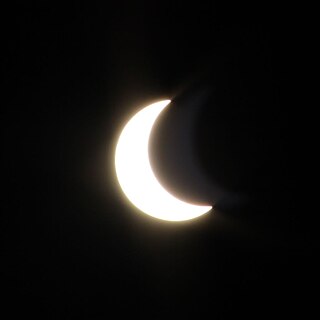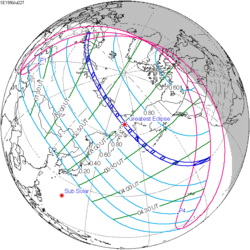Top Qs
Timeline
Chat
Perspective
Solar eclipse of February 26, 2017
2017 annular solar eclipse in South America and Africa From Wikipedia, the free encyclopedia
Remove ads
An annular solar eclipse occurred at the Moon's descending node of orbit on Sunday, February 26, 2017,[1][2][3][4] with a magnitude of 0.9922. A solar eclipse occurs when the Moon passes between Earth and the Sun, thereby totally or partly obscuring the image of the Sun for a viewer on Earth. An annular solar eclipse occurs when the Moon's apparent diameter is smaller than the Sun's, blocking most of the Sun's light and causing the Sun to look like an annulus (ring). An annular eclipse appears as a partial eclipse over a region of the Earth thousands of kilometres wide. Occurring about 4.9 days before perigee (on March 3, 2017, at 13:30 UTC), the Moon's apparent diameter was larger.[5]
The eclipse was visible across southern Chile and Argentina in the morning and ended in Angola and southwestern Katanga, Democratic Republic of the Congo at sunset. In Argentina, the best places to see the eclipse were located in the south of the Chubut Province, in the towns of Facundo, Sarmiento and Camarones. A partial eclipse was visible for parts of southern South America, southern and western Africa, and Antarctica.
Remove ads
Images
Eclipse timing
Places experiencing annular eclipse
Places experiencing partial eclipse
Remove ads
Gallery
- Partial from Villa Gesell, Argentina, 13:18 GMT
- Coyhaique, Chile, 13:35 GMT, 1 minute before annularity
- Partial from Pisco Elqui, Chile, 13:48 GMT
- Partial from Punta del Este, Uruguay, 13:56 GMT
- Partial from Puerto Cisnes, Chile, 14:17 GMT
- Composed image as seen from Paraná, Argentina
- Time lapse images as seen from Villa Gesell, Argentina
- Animation of the eclipse as seen from Montevideo, Uruguay
Eclipse details
Summarize
Perspective
Shown below are two tables displaying details about this particular solar eclipse. The first table outlines times at which the Moon's penumbra or umbra attains the specific parameter, and the second table describes various other parameters pertaining to this eclipse.[6]
Remove ads
Eclipse season
This eclipse is part of an eclipse season, a period, roughly every six months, when eclipses occur. Only two (or occasionally three) eclipse seasons occur each year, and each season lasts about 35 days and repeats just short of six months (173 days) later; thus two full eclipse seasons always occur each year. Either two or three eclipses happen each eclipse season. In the sequence below, each eclipse is separated by a fortnight.
Remove ads
Related eclipses
Eclipses in 2017
- A penumbral lunar eclipse on February 11.
- An annular solar eclipse on February 26.
- A partial lunar eclipse on August 7.
- A total solar eclipse on August 21.
Metonic
- Preceded by: Solar eclipse of May 10, 2013
- Followed by: Solar eclipse of December 14, 2020
Tzolkinex
- Preceded by: Solar eclipse of January 15, 2010
- Followed by: Solar eclipse of April 8, 2024
Half-Saros
- Preceded by: Lunar eclipse of February 21, 2008
- Followed by: Lunar eclipse of March 3, 2026
Tritos
- Preceded by: Solar eclipse of March 29, 2006
- Followed by: Solar eclipse of January 26, 2028
Solar Saros 140
- Preceded by: Solar eclipse of February 16, 1999
- Followed by: Solar eclipse of March 9, 2035
Inex
- Preceded by: Solar eclipse of March 18, 1988
- Followed by: Solar eclipse of February 5, 2046
Triad
- Preceded by: Solar eclipse of April 28, 1930
- Followed by: Solar eclipse of December 29, 2103
Solar eclipses of 2015–2018
This eclipse is a member of a semester series. An eclipse in a semester series of solar eclipses repeats approximately every 177 days and 4 hours (a semester) at alternating nodes of the Moon's orbit.[7]
The partial solar eclipse on July 13, 2018 occurs in the next lunar year eclipse set.
Saros 140
This eclipse is a part of Saros series 140, repeating every 18 years, 11 days, and containing 71 events. The series started with a partial solar eclipse on April 16, 1512. It contains total eclipses from July 21, 1656 through November 9, 1836; hybrid eclipses from November 20, 1854 through December 23, 1908; and annular eclipses from January 3, 1927 through December 7, 2485. The series ends at member 71 as a partial eclipse on June 1, 2774. Its eclipses are tabulated in three columns; every third eclipse in the same column is one exeligmos apart, so they all cast shadows over approximately the same parts of the Earth.
The longest duration of totality was produced by member 11 at 4 minutes, 10 seconds on August 12, 1692, and the longest duration of annularity will be produced by member 53 at 7 minutes, 35 seconds on November 15, 2449. All eclipses in this series occur at the Moon’s descending node of orbit.[8]
Metonic series
The metonic series repeats eclipses every 19 years (6939.69 days), lasting about 5 cycles. Eclipses occur in nearly the same calendar date. In addition, the octon subseries repeats 1/5 of that or every 3.8 years (1387.94 days). All eclipses in this table occur at the Moon's descending node.
Tritos series
This eclipse is a part of a tritos cycle, repeating at alternating nodes every 135 synodic months (≈ 3986.63 days, or 11 years minus 1 month). Their appearance and longitude are irregular due to a lack of synchronization with the anomalistic month (period of perigee), but groupings of 3 tritos cycles (≈ 33 years minus 3 months) come close (≈ 434.044 anomalistic months), so eclipses are similar in these groupings.
Inex series
This eclipse is a part of the long period inex cycle, repeating at alternating nodes, every 358 synodic months (≈ 10,571.95 days, or 29 years minus 20 days). Their appearance and longitude are irregular due to a lack of synchronization with the anomalistic month (period of perigee). However, groupings of 3 inex cycles (≈ 87 years minus 2 months) comes close (≈ 1,151.02 anomalistic months), so eclipses are similar in these groupings.
Remove ads
Notes and references
External links
Wikiwand - on
Seamless Wikipedia browsing. On steroids.
Remove ads





















































































































